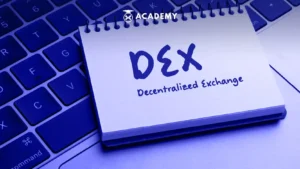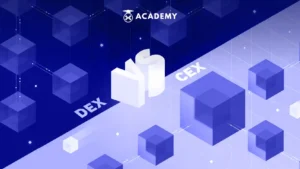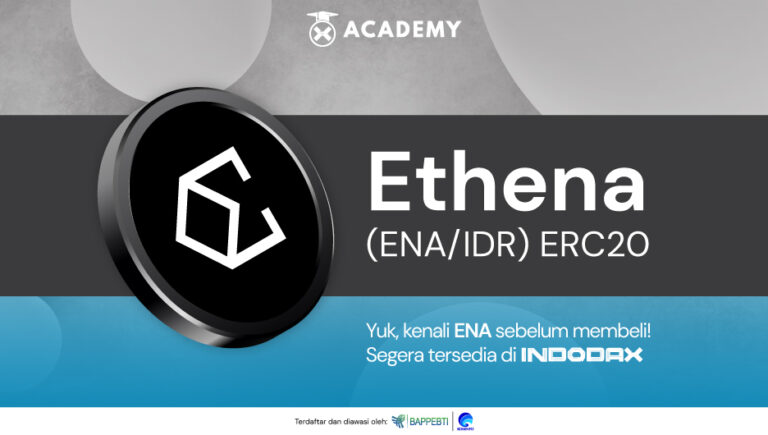With the development of technology, the trading of crypto assets has undergone a significant transformation, freeing it from the reliance on intermediaries or third parties. Decentralized Exchange (DEX) has revolutionized trading by implementing this innovation.
Every transaction occurs directly between users in a DEX without third-party intervention. DEX also offers transparent and decentralized transactions. Thus, DEX becomes a clear example of a crypto asset concept prioritizing decentralization through peer-to-peer transactions.
So, to understand what DEX is, how it works, how it differs from Centralized Exchange (CEX), its advantages and disadvantages, and its challenges in the future, read the following review!
What is DEX (Decentralized Exchange)?

Decentralized Exchange (DEX) is an exchange platform that operates explicitly in peer-to-peer transactions of cryptocurrencies and digital assets. In contrast to Centralized Exchange (CEX), DEX does not require a trusted third party or intermediary to facilitate the exchange of crypto assets.
The main principle in the crypto world is financial disintermediation, which means increasing the economic freedom of individuals around the globe, regardless of their background.
DEX plays a critical role as a component in Decentralized Finance (DeFi), and it could be argued that the incredible growth experienced by DeFi would be impossible without high-quality liquidity from DEXs.
DEXs initially gained popularity on the Ethereum network but have since migrated to various blockchains that support smart contracts. In the blockchain ecosystem, DEX plays a vital role because it is the first Decentralized Application (dAPP) that users usually access when they enter a new blockchain.
DEX is a way to trade crypto assets, allowing users to enter and exit their positions. In addition to facilitating exchanges between various crypto assets, many DEXs offer a way to acquire crypto assets without engaging in active trading. As of August 2023, 891 Decentralized Exchanges (DEX) are operating on various blockchain networks. Uniswap is the largest DEX, with Total Value Locked (TVL) reaching 3.6 billion US dollars, followed by Curve DEX, Pancakeswap, Balancer, SUN, and several other DEXs.
DEX also offers various activities on its platform that allow users to maximize the use of their funds. For example, users can trade crypto assets, earn interest from crypto staking, lend funds, become liquidity providers, speculate on prices using derivatives, etc.
How DEX Works
DEX users need a deep understanding as the user experience on these platforms tends to be more complex than Centralized Exchanges (CEX) operated by a central entity. Currently, there are several popular DEX designs, but there are two types that crypto users most widely use: DEX with an order book mechanism and Automated Market Maker (AMM).
Crypto users commonly use DEX aggregators as well. The function of the DEX Aggregator is to find optimal prices by comparing prices from various DEXes. DEX aggregators also consider the gas fees charged in their comparisons. The following is an explanation of how DEX works, namely:
1. Order Book
An order book is a system that collects records of buy and sell orders openly in the market in real time. DEXs with fully on-chain order book systems are generally less desirable because they face several challenges, including the need for high throughput and relatively high fees.
However, with developing scalability solutions such as layer 2 using optimistic rollups and ZK rollups technology, DEXs with on-chain order books are starting to attract the interest of crypto users.
A more popular type of system is a hybrid order book. In this system, the DEX matches orders off-chain while settlement remains on the blockchain (on-chain). Examples of DEXs with an order book mechanism include 0x, dYdX, Loopring DEX, and Serum.
2. Automated Market Makers (AMM)
AMM is the most widely used DEX mechanism because it allows users to access direct liquidity and become liquidity providers (LPs). LPs are essential in the AMM mechanism as they provide crypto assets for trading.
AMM was created to solve liquidity problems and uses blockchain oracles to determine traded asset prices. Users can directly buy or sell crypto assets through liquidity pools, while liquidity providers (who deposit assets into AMM liquidity pools) can earn passive income through trading fees.
Some examples of DEXs with AMM mechanisms include Uniswap, Balancer, Aave, Curve, and others.
Difference between DEX and CEX

A Centralized Exchange (CEX) is a crypto asset exchange platform operated by a central entity. Users must deposit their assets into an exchange account to buy or sell crypto assets.
CEX manages transactions and settles trades through its internal systems. The main difference between Decentralized Exchange (DEX) and CEX lies in their operation and structure.
DEX is a decentralized exchange platform that facilitates direct user trading through blockchain technology and smart contracts, giving users complete control over their assets and high transparency. On the other hand, CEXs are run by a central entity, require users to cede control of assets to the exchange, and transparency may be lower depending on the exchange’s policies. While DEXs offer advantages in privacy and lower involvement in regulations, CEXs can process transactions faster and are easier to use. The choice between the two depends on user preferences for asset control, transparency, speed, and regulatory compliance.
Advantages and Disadvantages of Decentralized Exchange
Knowing the advantages and disadvantages of Decentralized Exchange (DEX) is very important for crypto users and investors. Understanding the advantages of DEXs, such as complete control over assets and openness of transactions, can help users secure their crypto assets without relying on third parties.
Among other things, here are the advantages and disadvantages of DEX that you need to know:
1. Advantages of Decentralized Exchange (DEX)
- Full Control of Assets
One of the main advantages of DEX is that users have complete control over their assets. Users do not need to deposit funds into exchange accounts, increasing security by avoiding the risk of exchange hacks or unexpected account closures.
- Transparency and Openness
Every transaction in a DEX is recorded in a decentralized ledger that anyone can access. This increases transparency and openness, reducing the risk of data manipulation or false information.
- Privacy and Convenience
DEX does not require users to reveal their personal information, such as Know Your Customer (KYC). This preserves user privacy while allowing them to participate in crypto asset exchanges without worrying about privacy violations.
- Global Access
Geographic boundaries or special regulations do not restrict the DEX platform and anyone worldwide can access and trade on the DEX platform.
2. Disadvantages of Decentralized Exchange (DEX)
- Low Liquidity
Some DEXs may face lower liquidity issues, especially on less popular asset pairs, which can cause slippage (the difference between the expected and actual prices) on large trades.
- Risks of Smart Contracts
Although blockchain is considered secure, the code quality in a smart contract depends on the development team’s expertise. The risk of bugs, hacks, vulnerabilities, and smart contract exploits can threaten DEX users. Developers can reduce these risks through security audits and careful code inspection.
- Complex User Experience
Using DEXs can be more complex for users less experienced in crypto. Processes such as using smart contracts, setting gas fees, and network selection require a deeper understanding of blockchain technology.
Future DEX Challenges
As with all innovations, Decentralized Exchanges (DEX) also face several challenges. The speed and efficiency of transactions in DEX are still the focus of attention.
In addition, when problems occur in transactions or errors in smart contracts, the process of recovering funds can be more complex compared to Centralized Exchanges (CEX). However, DEXs have great potential to change the crypto exchange paradigm, giving more control to users and reducing dependence on central entities. With the continued development of blockchain technology and a maturing understanding of digital security, DEXs will likely remain a significant focus of attention in the crypto ecosystem in the future.
Conclusion
In conclusion, some of the advantages of DEX include having complete control over assets, transparency and openness, privacy and convenience, and global access. Regarding how it works, two types of mechanisms are popular today, namely order books and Automated Market Makers (AMM).
The order book system collects records of buy and sell orders openly in the market in real time. Meanwhile, users widely use AMM as the DEX mechanism since it enables them to access direct liquidity and become liquidity providers (LPs). On the other hand, some of the risks of DEX include, among others, the vulnerability of smart contracts, loss of funds, low liquidity, fraud and scam projects, no insurance protection, and no regulatory oversight.
Furthermore, it is essential always to be careful and research before using a Decentralized Exchange (DEX). That’s because DEXs offer complete freedom and control over crypto assets, but with that freedom also comes great responsibility. Doing thorough research before using a DEX is a smart move that helps protect investments, privacy, and security. In this case, always use proven platforms, study reviews and recommendations from trusted crypto communities, and continuously improve your understanding of the DEX ecosystem.
Invest in Crypto on INDODAX
So, now you understand what DEX is, how it works, how it differs from Centralized Exchange (CEX), its advantages and disadvantages, and its challenges in the future.
Next, after you understand and understand DEX, it’s a good idea for you to choose the best and most trusted CEX, like INDODAX. The reason is that when choosing a CEX, factors such as security, liquidity, reputation, and customer support must be seriously considered. INDODAX, as a leading crypto exchange platform, offers users a safe, transparent, and reliable trading experience. Choosing a trusted exchange ensures the safe management of your crypto assets and guarantees access to responsive and competent customer service.
So what are you waiting for? Let’s invest in crypto now on INDODAX!








